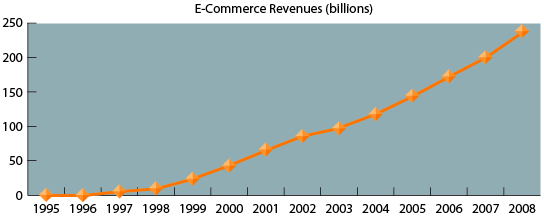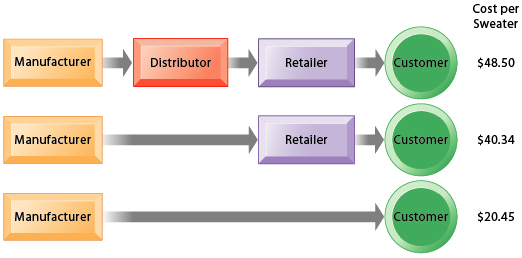| Section 10.1: Bullet Text Study Guide |
Electronic Business, Electronic Commerce, and the Emerging Digital Firm
E-commerce refers to:
- The use of the Internet and the Web to transact business
- Digitally enabled commercial transactions between and among organizations and individuals.
Figure 10-1
 |
|
The rapid growth of e-commerce since 1995 is due to the unique features of the Internet and the Web as a commercial medium:
- Ubiquity: Internet/Web technology is everywhere, at work, home, and elsewhere, and anytime, providing a ubiquitous marketspace, a marketplace removed from a temporal and geographical location.
- Global reach: The technology reaches across national boundaries.
- Universal standards: There is one set of Internet technology standards, which greatly lower market entry costs (the costs to bring goods to market) and reduce search costs (the effort to find products) for the consumer.
- Richness: Information richness refers to the complexity and content of a message. Internet technology allows for rich video, audio, and text messages to be delivered to large numbers of people.
- Interactivity: The technology works through interaction with the user.
- Information density: Information density is the total amount and quality of information available to all market participants. Internet technology reduces information costs and raises quality of information, enabling price transparency (the ease for consumers of finding a variety of prices) and cost transparency (the ability of consumers to determine the actual costs of products). Information density allows merchants to engage in price discrimination (selling goods to targeted groups at different prices).
- Personalization/customization: E-commerce technologies permit personalization (targeting personal messages to consumers) and customization (changing a product or service based on consumer preference or history.
The Internet also shrinks information asymmetry, which occurs when one party in a transaction has more information with respect to the transactions than the other party. For instance, the Web has reduced the information asymmetries surrounding auto purchases.
Digital markets are very flexible and efficient because they allow:
- Reduced search and transaction costs
- Lower menu costs (merchant's costs of changing prices)
- Price discrimination
- Dynamic pricing (prices changing based on the demand characteristics of the customer or the seller's supply situation)
- Disintermediation: Elimination of intermediaries such as distributors or retailers
Figure 10-2
 |
|
The Internet digital marketplace has also greatly expanded sales of digital goods, goods that can be delivered over a digital network. In comparison to traditional goods, the marginal cost of producing another unit of a digital good is about zero, delivery costs over the Internet are low, while marketing costs are about the same and pricing can be variable.
E-commerce technologies have revolutionized commerce and enabled a variety of new business models. Some are pure-play models, based purely on the Internet. Others may be hybrid clicks-and-mortar models, using Web sites as an extension of a traditional business, such as LLBean.com. New business models include:
- Virtual storefronts: Such as Amazon.com
- Information broker: Such as Realtor.com
- Transaction broker: Such as E*Trade.com
- Online marketplace: Such as Ebay.com
- Content provider: Such as iTunes.com. The ability to deliver digital goods and digital content over the Web has created new alternatives to traditional print and broadcast media. Popular digital content includes online games, digital versions of print newspapers, Internet radio, downloadable movies, online television broadcasts, Podcasting (Internet audio broadcasts).
- Online service provider: Such as Salesforce.com.
- Virtual community: Such as YouTube.com; Online communities include social networking sites, online communities used by individuals for expanding business or social contacts, and social shopping sites, in which users swap shopping ideas.
- Portal: Such as Yahoo.com. Some portals combine content from various sources, using syndication as well providing additional value. Online syndicators aggregate content or applications from multiple sources, package them for distribution, and resell them to third-party Web sites
These new business models may have revenue generated from:
- Sales of traditional or digital goods
- Selling advertising space for banner ads and pop-up ads
- Transaction fees
- Sales of marketing information collected by users
- Directing buyers to sellers